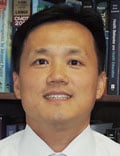Transcranial direct-current stimulation (tDCS), performed at home but supervised remotely, is feasible and effective in managing osteoarthritis (OA) pain in older adults, new research shows.
In a small, open-label study of 20 patients with knee OA, 2 weeks of at-home treatment with tDCS significantly reduced pain scores by more than 50%. In addition, the treatment was well tolerated.

Dr Hyochol Brian Ahn
“Osteoarthritis is the most common cause of pain in older adults, and the knee is the most commonly affected joint,” study investigator Hyochol Brian Ahn, PhD, Isla Carroll Turner Chair in Gerontological Nursing, University of Texas Health Science Center, Houston, Texas, told Medscape Medical News.
“Managing osteoarthritis pain is particularly challenging in older adults because the pain is only partially responsive to existing pharmacological approaches, plus these drugs can often come with significant adverse events,” he added.
The findings were presented at the virtual American Academy of Pain Medicine (AAPM) 2021 Annual Meeting.
The Brain as a Pain Regulator
There is growing interest in the role the brain plays in pain regulation, said Ahn. Previous research suggests that tDCS produces analgesic effects.
“We determine the severity of knee osteoarthritis by x-ray, but often, the severity of the osteoarthritis does not correlate with the patient’s perception of the pain. We see joints that are completely worn out, and yet patients aren’t complaining about pain or disability.
“Thinking about this disconnect has led to a consensus that the brain, which is an electrochemical organ, has a role to play in pain management,” he added.
Ahn recently started using tDCS to treat his elderly patients with knee OA. He observed improvement in their pain scores. The only problem, he said, is that patients have to come into the clinic every weekday for 2 weeks, which can be burdensome for some patients.
To assess the feasibility and efficacy of providing self-administered, remotely supervised tDCS, Ahn studied 20 patients (15 women, five men) with knee OA for a mean of 30 months. Patients ranged in age from 50 to 85 years.
The tDCS intervention consisted of a constant, 2-mA current applied for 20 minutes once per day Monday through Friday for 2 weeks for a total of 10 sessions. Patients received the tDCS equipment and were remotely supervised by trained research staff at each treatment session.
Pain intensity was measured using the Visual Analogue Scale (VAS). On that scale, scores range from 0 mm, indicating no pain, to 100 mm, indicating worst pain imaginable. After 2 weeks of home-based treatment, the average VAS score was significantly reduced from baseline, dropping from 55.23 at the start of the treatment to 24.85 by the end of treatment (P < .01).
On the basis of the positive findings from this pilot study, Ahn has been awarded a 3-year grant by the National Institutes of Health (NIH) to continue his research.
“Right now, we are recruiting 120 patients and will randomize them to receive the intervention or a sham intervention to elevate our findings on the analgesic effect of a home-based application of transcranial direct current stimulation in older adults,” he said.
Still Early Days
Commenting on the research for Medscape Medical News, W. Michael Hooten, MD, professor of anesthesiology at the Mayo Clinic, Rochester, Minnesota, said that although these early findings are positive, “long-term pain outcomes and the potential effects of tDCS on physical and emotional functioning await results of the NIH-funded RCT [randomized control trial].”

Dr Ajay J. Wasan
Also commenting on the findings, Ajay J. Wasan, MD, professor of anesthesiology, perioperative medicine, and psychiatry, University of Pittsburgh School of Medicine, Pittsburgh, Pennsylvania, said the investigators “seem to have conquered the issue of how to deliver transcranial stimulation at home.”
He added that although the results are encouraging, the modality and delivery method “definitely need to be tested in a randomized controlled trial to determine if this is indeed an efficacious treatment.”
The study was funded by the Theodore J. and Mary E. Trumble Endowment of the University of Texas Health Science Center at Houston. Ahn, Wooten, and Wasan report no relevant financial relationships.
American Academy of Pain Medicine (AAPM) 2021 Annual Meeting.
For more Medscape Neurology news, join us on Facebook and Twitter.
Source: Read Full Article
